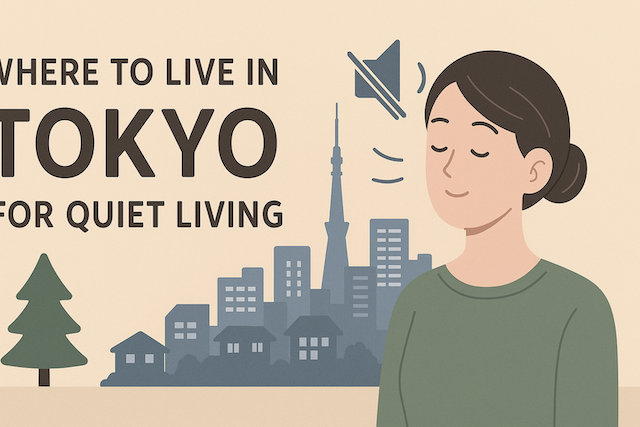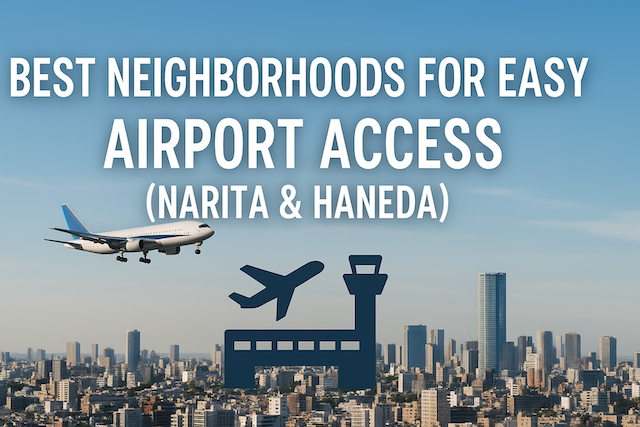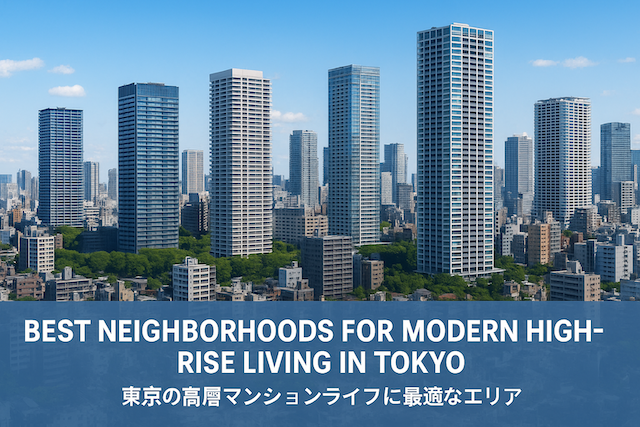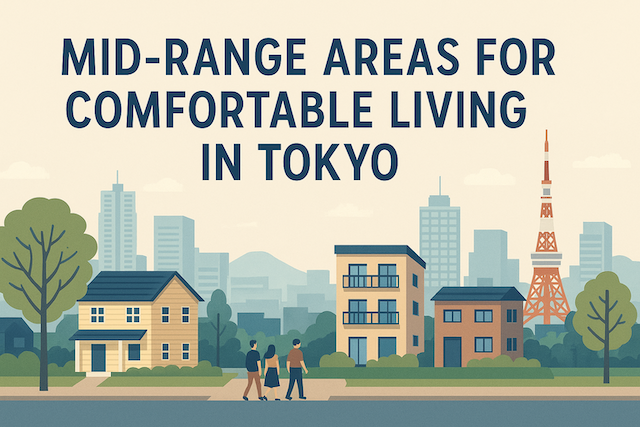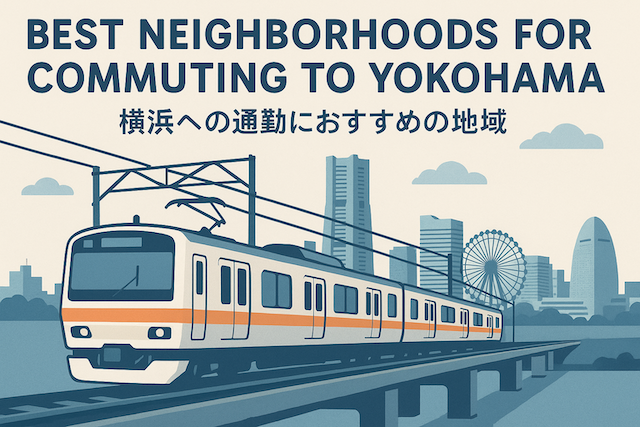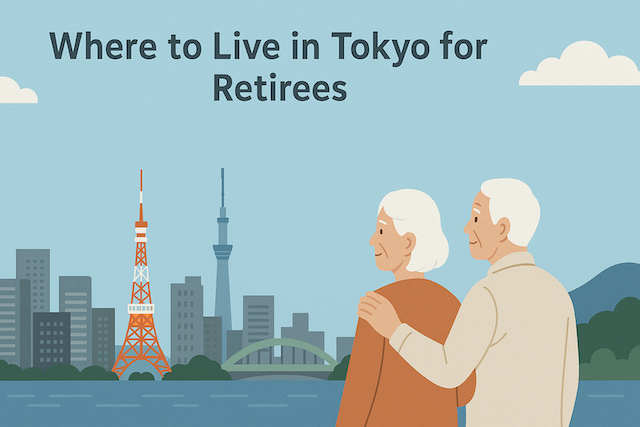Where to Live in Tokyo for Quiet Living
Tokyo is one of the most vibrant and dynamic cities in the world, but not everyone wants to live in the middle of constant noise and crowds. For many professionals, families, and introverts, finding a peaceful neighborhood is essential to maintaining a balanced lifestyle. Fortunately, Tokyo offers many calm, green, and residential areas where you can enjoy the convenience of city life without the chaos.
This guide introduces the best neighborhoods in Tokyo for quiet living, focusing on areas with low noise levels, access to nature, and a relaxed community atmosphere.
Why Choose a Quiet Area in Tokyo
Life in central Tokyo can be thrilling, but it can also be overwhelming. Train stations are packed, nightlife is loud, and apartments close to commercial areas can suffer from constant traffic noise.
Choosing a quieter area can improve your quality of life in several ways:
-
Better sleep and health: Less traffic and nightlife noise means better rest.
-
More space and greenery: Many quiet areas have larger parks and open spaces.
-
Community feeling: Residential neighborhoods often have a close-knit, friendly atmosphere.
-
Balanced lifestyle: You can still reach central Tokyo easily while enjoying peace at home.
Characteristics of Quiet Neighborhoods in Tokyo
When looking for a quiet area, consider these factors:
-
Distance from major train lines – Areas slightly away from the busiest stations (like Shibuya or Shinjuku) tend to be quieter.
-
Residential zoning – Some neighborhoods are primarily residential with fewer bars and entertainment venues.
-
Green spaces – Parks, rivers, and gardens naturally create calmer environments.
-
Building density – Fewer high-rises and wider streets contribute to a more relaxed feel.
1. Setagaya – The Classic Peaceful Suburb
Setagaya Ward is one of Tokyo’s most popular choices for people who value tranquility and space. It’s primarily residential, filled with tree-lined streets, family homes, and cozy cafés.
Highlights:
-
Areas like Sangenjaya, Komazawa-Daigaku, and Yoga offer a perfect mix of calm and convenience.
-
Komazawa Olympic Park provides wide green areas for jogging, cycling, or relaxing.
-
The Den-en-toshi Line connects easily to Shibuya, making commuting simple.
Who it’s for: Families, working professionals, and anyone who prefers suburban comfort with quick city access.
2. Kichijoji – Balance of Nature and Lifestyle
Located in Musashino City, Kichijoji is consistently ranked as one of the most desirable places to live in Tokyo. Despite its popularity, it maintains a calm, relaxed feel thanks to Inokashira Park, one of Tokyo’s most beautiful green spaces.
Highlights:
-
Inokashira Park offers walking paths, a lake, and cherry blossoms in spring.
-
Many small local shops, organic cafés, and independent bookstores give the area a unique charm.
-
About 20 minutes from Shinjuku by Chuo Line.
Who it’s for: Nature lovers, creative individuals, and those who enjoy a small-town feel within Tokyo.
3. Meguro – Quiet Elegance Near the Center
Meguro Ward is known for its sophisticated yet understated atmosphere. While it’s close to Shibuya and Ebisu, it feels more refined and peaceful.
Highlights:
-
The Meguro River area is famous for cherry blossoms and scenic walks.
-
Residential districts like Gakugei-Daigaku and Yutenji are peaceful but trendy.
-
Great access to transport, with the Meguro and Tokyu lines connecting across the city.
Who it’s for: Young professionals and couples who want a stylish yet calm environment.
4. Nakameguro – Trendy but Surprisingly Calm
Nakameguro may have a reputation for being fashionable, but beyond the main river area, it’s very serene. The quiet backstreets filled with boutique shops and minimalist cafés make it ideal for a relaxed lifestyle.
Highlights:
-
The Meguro River walkway is peaceful except during cherry blossom season.
-
Close to Daikanyama and Ebisu but with a slower rhythm.
-
Modern apartments mixed with older homes give a cozy, balanced vibe.
Who it’s for: Digital nomads, artists, and those who like a calm but connected area.
5. Denenchofu – Tokyo’s Most Prestigious Suburban Haven
Denenchofu in Ota Ward is often compared to Beverly Hills or Hampstead for its elegant residential design and spacious homes. It was developed as a “garden city,” designed for peaceful living surrounded by greenery.
Highlights:
-
Wide streets, quiet atmosphere, and European-style architecture.
-
Excellent schools and safety make it ideal for families.
-
Conveniently connected to Shibuya and Meguro via Tokyu Toyoko Line.
Who it’s for: Affluent families and professionals who value luxury and tranquility.
6. Koenji – Relaxed, Local, and Underrated
While Koenji is known for its vintage clothing shops and music scene, its residential zones are surprisingly quiet. Once you move away from the station area, the backstreets become calm and community-oriented.
Highlights:
-
Strong neighborhood culture with local festivals and mom-and-pop stores.
-
Affordable rent compared to central Tokyo.
-
Only 10 minutes to Shinjuku by Chuo Line.
Who it’s for: Those who want an artistic, down-to-earth neighborhood that still feels peaceful.
7. Naka-Meguro and Daikanyama Border Area
Between Nakameguro and Daikanyama lies one of Tokyo’s most refined residential zones. It’s quiet, leafy, and filled with high-quality cafés and boutiques.
Highlights:
-
Walkable, safe streets perfect for evening strolls.
-
Elegant architecture and low-rise buildings maintain the area’s quiet charm.
-
Close to both Shibuya and Ebisu.
Who it’s for: Professionals and couples seeking understated elegance.
8. Jiyugaoka – Calm, Stylish, and Family-Friendly
Jiyugaoka is known for its European-style streets and relaxed lifestyle. It’s a favorite among Tokyo residents who want both charm and calm.
Highlights:
-
Tree-lined streets and stylish cafés create a laid-back vibe.
-
Well-connected by Tokyu Toyoko and Oimachi Lines.
-
Good schools and shopping for daily convenience.
Who it’s for: Families and people who appreciate aesthetic and comfort.
9. Yoyogi-Uehara – Quiet Yet Central
Yoyogi-Uehara offers a rare combination of quiet streets and central location. Just minutes from Shinjuku, it feels like a hidden oasis within the heart of Tokyo.
Highlights:
-
Elegant residential blocks with spacious apartments.
-
Nearby Yoyogi Park provides large green spaces.
-
Upscale but not pretentious.
Who it’s for: Professionals and expats who need central access but prefer tranquility.
10. Todoroki – Tokyo’s Hidden Green Gem
Located in Setagaya, Todoroki is home to the famous Todoroki Valley, a natural ravine with a small river running through it. It’s one of the few places in Tokyo where you can feel completely surrounded by nature.
Highlights:
-
Quiet residential streets with traditional houses.
-
The valley offers a peaceful walking path and scenic beauty.
-
Good access via the Tokyu Oimachi Line.
Who it’s for: Nature lovers and anyone seeking deep calm within the city.
Tips for Finding Quiet Apartments in Tokyo
-
Check distance from main roads and train lines. Even a few hundred meters can make a big difference in noise level.
-
Avoid nightlife zones. Stay away from areas with izakayas or karaoke bars.
-
Visit at different times of day. Some areas are quiet in the morning but noisy at night.
-
Look for top-floor or corner units. These tend to reduce noise from neighbors.
-
Use Japanese property terms: Search for listings labeled as “静かな住宅地” (quiet residential area) or “閑静なエリア.”
Summary: Best Areas for Quiet Living in Tokyo
| Area | Character | Access | Ideal For |
|---|---|---|---|
| Setagaya | Suburban, family-oriented | 15–25 mins to Shibuya | Families, professionals |
| Kichijoji | Nature and lifestyle | 20 mins to Shinjuku | Nature lovers |
| Meguro | Elegant, quiet | Central Tokyo | Couples, expats |
| Nakameguro | Trendy but calm | Near Shibuya | Creatives, freelancers |
| Denenchofu | Luxury garden city | 20 mins to Shibuya | Families, executives |
| Koenji | Relaxed, local | 10 mins to Shinjuku | Artists, young professionals |
| Jiyugaoka | Stylish, serene | 15 mins to Shibuya | Families, couples |
| Yoyogi-Uehara | Central oasis | 5 mins to Shinjuku | Professionals |
| Todoroki | Natural and hidden | 25 mins to center | Nature enthusiasts |
Final Thoughts
Quiet living in Tokyo is absolutely possible. Whether you prefer the elegance of Meguro, the natural charm of Kichijoji, or the suburban comfort of Setagaya, the city offers peaceful havens that balance calm and convenience. By choosing the right neighborhood, you can enjoy all the benefits of Tokyo life—without the stress and noise.
Living in a quiet area helps you recharge, focus, and truly appreciate the beauty of Japan’s capital from a different perspective.
What are the quietest neighborhoods in Tokyo for everyday living?
Consistently calm choices include Setagaya (Sangenjaya, Komazawa-Daigaku, Yoga), Meguro (Gakugei-Daigaku, Yutenji), Jiyugaoka, Yoyogi-Uehara, Denenchofu, Kichijoji (technically Musashino City), Nakameguro’s backstreets, and Todoroki. These areas balance low nightlife activity, tree-lined streets, and quick rail access while avoiding the 24/7 bustle of Shinjuku and Shibuya cores.
How can I verify if a street is truly quiet before signing a lease?
Visit at multiple times: weekday rush hour, late evening (bar closing), and weekend midday. Listen for rail noise, emergency sirens, delivery bikes, and nearby construction. Check distance to main arteries and elevated tracks. Ask the agent about soundproofing (double-glazing, concrete walls) and look for corner or top-floor units to reduce neighbor noise.
Which train lines are convenient yet quieter around stations?
Tokyu Den-en-toshi, Tokyu Toyoko, and Tokyu Oimachi lines serve many calm Setagaya–Meguro pockets. The Chuo Line offers quick links to Shinjuku from quieter stops west of the core (Kichijoji, Nishi-Ogikubo) if you live a few blocks off the station. Odakyu and Keio Inokashira lines also connect peaceful residential streets with central hubs efficiently.
Are parks and rivers good indicators of a quiet atmosphere?
Yes. Proximity to green spaces often correlates with calmer surroundings and slower traffic. Examples include Komazawa Olympic Park (Setagaya), Meguro River promenades (outside peak sakura), Inokashira Park (Kichijoji), Yoyogi Park edges (near Yoyogi-Uehara), and Todoroki Valley. Still, check event schedules and seasonal crowds (e.g., cherry blossom weeks).
Does “閑静な住宅街” in listings actually guarantee quiet?
It’s a positive signal but not a guarantee. The phrase is commonly used in Japanese listings to market residential calm. Always confirm with in-person checks, ask about building age and sound insulation, and verify the distance to karaoke bars, late-night izakaya, and multi-tenant entertainment buildings near the station.
What building features most reduce noise inside the apartment?
Reinforced concrete (RC) structures, double-paned windows, solid-core doors, airtight balcony sliders, and modern HVAC units help. Request the building’s wall and floor specs, ask whether there’s acoustic underlayment, and prefer layouts with bedrooms away from corridors, elevators, and roads. South- or courtyard-facing units often experience gentler ambient sound.
Is it better to live right next to a station or a few blocks away?
For quiet living, a 7–12 minute walk from the station is often the sweet spot. You’ll avoid foot-traffic peaks, taxi queues, and bar districts clustered near the ticket gates. Streets one or two blocks behind the main shotengai (shopping street) typically offer calmer nights while keeping your commute practical.
How do seasons affect noise in “quiet” areas?
Cherry blossom season (late March–early April) brings crowds to riversides such as Nakameguro and parks like Inokashira. Summer matsuri and fireworks can increase evening noise. Typhoon cleanups may involve early-morning trucks. If you’re sensitive, choose streets away from festival routes and park gates, or favor neighborhoods without major hanami hotspots.
Are there quiet options that still feel stylish and central?
Yes. Meguro’s residential pockets, Yutenji, Daikanyama–Nakameguro borders, and Yoyogi-Uehara provide understated aesthetics, good dining, and strong transit while remaining calm after 10 p.m. These areas rely more on cafés and boutiques than nightlife venues, which naturally limits late-night disturbances.
What rent trade-offs should I expect for quieter neighborhoods?
Expect to pay a modest premium for low-rise, tree-lined streets within 20–30 minutes of major hubs, especially in Meguro, Jiyugaoka, and Yoyogi-Uehara. More affordable calm can be found slightly farther out in Setagaya or west of Kichijoji. Newer RC buildings with good insulation also command higher rents than comparable wooden structures.
How can I minimize upstairs and neighbor noise?
Choose top-floor or corner units, avoid units facing internal courtyards with echo, and ask about tenant demographics (families with small children versus working professionals). In multi-story wood or lightweight steel buildings, footsteps travel more; RC construction is safer. Bring a small rubber ball to test floor thuds during viewing with permission.
Are single-family homes (戸建て) quieter than apartments?
Detached homes can be peaceful when set back from main roads, but they may admit more outside sound than well-insulated RC apartments. Apartments with strict management rules often curb hallway noise. If choosing a house, confirm double glazing, insulation quality, and boundary walls or hedges that dampen street sound.
Which daily-life conveniences matter for quiet living?
Prioritize calm supermarkets, early-closing cafés, and minimal late-night venues within 200–300 meters. Look for residential zoning, narrow local streets instead of bus routes, and delivery lockers to reduce doorbells. A bicycle can let you shop a bit farther away while keeping your immediate block tranquil.
What search keywords help find quiet listings online?
Use “閑静な住宅街,” “静かな環境,” “低層住宅エリア,” “防音,” and “二重サッシ.” Pair with station names known for residential character (e.g., Yutenji, Komazawa-Daigaku, Yoga, Jiyugaoka, Yoyogi-Uehara, Kichijoji, Todoroki). Filter out nightlife-heavy addresses and check street view for bars, clubs, and pachinko parlors.
Any final tip for balancing commute and calm?
Start by mapping your workplace and identifying two or three lines that connect efficiently. Then search one or two stops beyond the big hubs, focusing on low-rise residential blocks a short walk from the station. Visit at night, listen carefully, and choose a layout and building spec that align with your personal noise sensitivity.
https://tokyorelocationguide.com/neighborhoods/

